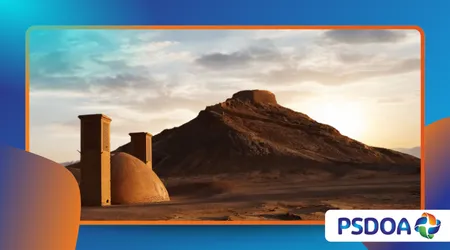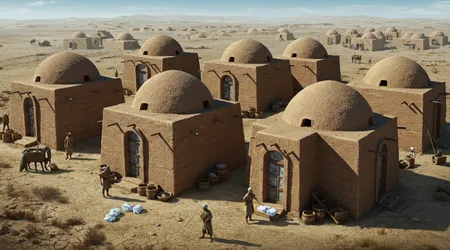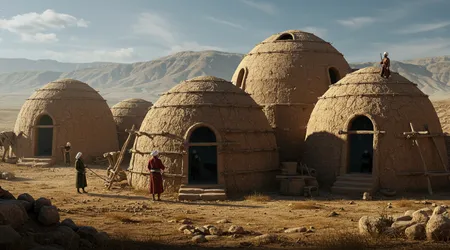The Ice Houses of Ancient Persia: Natural Refrigeration Without Electricity

Ice houses of ancient Persia stand as testaments to human ingenuity, harnessing nature’s forces to preserve food in scorching deserts without electricity.
Anúncios
These architectural marvels, known as yakhchāls, reveal a civilization that mastered sustainable cooling over 2,400 years ago.
In a world grappling with energy crises in 2025, their passive cooling techniques offer lessons in eco-friendly innovation.
This article explores the brilliance of these structures, their cultural significance, and their relevance to modern sustainability efforts, inviting readers to rediscover a forgotten invention that could inspire future solutions.
Why do we overlook such groundbreaking ideas? The ice houses of ancient Persia challenge our tech-obsessed mindset, showing that ancient wisdom can rival modern advancements.
Anúncios
Let’s dive into their design, functionality, and enduring legacy.
Engineering Marvels of the Yakhchāl
Ancient Persian engineers crafted the ice houses of ancient Persia with precision, using locally sourced materials like clay, straw, and egg whites.
The yakhchāl’s dome-shaped structure maximized thermal mass, keeping interiors cool.
Subterranean chambers, often 5,000 cubic meters, stored ice year-round. A 2016 study by Brad Smithfield noted their evaporative cooling efficiency, reducing temperatures by up to 10°C.
Shade walls protected ice-making pools from daytime sun, enabling ice formation on clear winter nights. Radiative cooling, where heat escapes to the night sky, was key.
This passive system required no external energy, unlike modern refrigerators. The ice houses of ancient Persia were built to last, with some still standing in Yazd, Iran.
The mortar, called sarooj, blended goat hair and ash for waterproofing and insulation. This ensured minimal heat transfer, preserving ice through brutal summers.
++ Self-Cleaning Clothes: A Forgotten Innovation That Still Impresses
Compare this to a thermos: simple design, profound effect. The yakhchāls’ sustainability outshines energy-hungry cooling systems today.
Windcatchers, or bâdgirs, funneled cool air into the structure, enhancing convection. These towers, often square or octagonal, predated modern ventilation systems.
Their integration with qanats underground aqueducts shows a holistic approach to resource management, a model for 2025’s green architecture.

Cultural and Practical Significance
In ancient Persia, ice houses of ancient Persia were more than storage; they were cultural hubs.
Communities gathered to enjoy faloodeh, a chilled dessert, during summer festivals. Ice preserved food, enabling trade across arid regions, boosting economic stability.
Royal courts used ice to showcase wealth, serving chilled drinks to guests. This social prestige mirrored modern luxury, like owning a high-end fridge.
The ice houses of ancient Persia democratized access to cooling, benefiting both elites and commoners.
Zoroastrian rituals incorporated ice, symbolizing purity. Temples stored sacred offerings in yakhchāls, blending utility with spirituality.
Also read: 17th Century Submarines: A Century Ahead of Their Time
This fusion of practicality and culture underscores Persia’s innovative mindset, often underappreciated in historical narratives.
By 400 BCE, Persians mastered ice production in deserts, a feat unmatched globally. Their techniques spread to the Arab world, influencing granita and gelato.
The ice houses of ancient Persia thus shaped culinary traditions far beyond their borders.
Sustainability Lessons for 2025
Today’s energy crisis makes the ice houses of ancient Persia strikingly relevant. Modern refrigeration consumes 17% of global electricity, per a 2023 UN report.
Yakhchāls, using zero energy, offer a blueprint for sustainable cooling. Architects in Iran are reviving these designs for low-energy housing.
Passive cooling principles, like radiative cooling, are now studied in universities worldwide. For example, Stanford researchers in 2024 developed panels inspired by yakhchāls, reflecting heat into space.
The ice houses of ancient Persia prove that low-tech solutions can address high-tech problems.
Imagine a rural community in 2025 building a yakhchāl-inspired cooler for food storage, cutting reliance on diesel generators.
This could transform food security in off-grid areas, like parts of sub-Saharan Africa. The ingenuity of Persia’s past speaks to our future.
Read more: The Phaistos Disc: An Ancient Communication Mystery
Retrofitting urban buildings with windcatchers could reduce air conditioning costs. In Dubai, architects are experimenting with bâdgir-inspired towers, echoing Persian designs.
The ice houses of ancient Persia remind us that sustainability isn’t new it’s ancient.
Challenges and Preservation Efforts
Despite their brilliance, many ice houses of ancient Persia face decay due to neglect and modern refrigeration’s dominance.
In Yazd, only a few yakhchāls remain functional, preserved as tourist sites. UNESCO’s 2022 heritage initiatives aim to restore these structures.
Local communities struggle to maintain yakhchāls amid urbanization. Funding shortages hinder conservation, as modern priorities overshadow historical value.
Yet, these ice houses of ancient Persia hold untapped potential for eco-tourism and education.
In 2025, Iranian architects advocate for yakhchāl-inspired public spaces, blending heritage with innovation.
For instance, a Tehran project integrates evaporative cooling into community centers, reviving ancient techniques. Such efforts bridge past and present, ensuring cultural continuity.
Public awareness campaigns, like Iran’s “Rediscover Yakhchāl” festival, engage youth in preservation. Schools teach students about passive cooling, fostering pride in Persian ingenuity.
Saving the ice houses of ancient Persia is about more than structures it’s about reclaiming wisdom.
A Call to Reimagine Cooling

The ice houses of ancient Persia challenge us to rethink cooling in an overheating world.
Their zero-energy design contrasts with our reliance on fossil-fuel-powered systems. Could we blend ancient and modern to create hybrid solutions?
Picture a skyscraper in 2025 with a yakhchāl-inspired core, using radiative panels and windcatchers to slash energy use.
This isn’t sci-fi it’s feasible, grounded in Persia’s proven methods. The ice houses of ancient Persia invite bold innovation.
Governments could incentivize passive cooling in building codes, drawing from yakhchāl principles.
In India, where heatwaves strain grids, such policies could save lives. Persia’s legacy offers practical, scalable ideas for a warming planet.
Let’s honor the ice houses of ancient Persia by applying their lessons. They’re not relics but roadmaps to sustainability. In 2025, as climate challenges intensify, their wisdom feels more urgent than ever.
Table: Yakhchāl Design Features and Benefits
| Feature | Description | Benefit |
|---|---|---|
| Dome Shape | Conical structure with vents | Enhances convection, expels hot air |
| Sarooj Mortar | Waterproof mix of clay, egg whites, ash | Insulates, prevents heat transfer |
| Subterranean Chamber | Deep underground storage, up to 5,000 m³ | Maintains low temperatures year-round |
| Windcatchers (Bâdgirs) | Towers channeling cool air | Improves ventilation, supports cooling |
| Qanat Integration | Underground water channels | Supplies water for evaporative cooling |
Conclusion
The ice houses of ancient Persia are more than historical curiosities they’re beacons of sustainable innovation.
In 2025, as we face climate and energy challenges, their passive cooling techniques offer timeless solutions.
From Yazd’s deserts to modern cities, yakhchāls inspire architects, engineers, and policymakers to rethink how we cool our world.
Their cultural legacy, from faloodeh to Zoroastrian rituals, reminds us that technology can serve both utility and community.
By preserving these structures and adapting their principles, we honor Persia’s genius while building a greener future. The ice houses of ancient Persia aren’t forgotten they’re waiting to be rediscovered. Let’s answer their call.
Frequently Asked Questions
Q: How did the ice houses of ancient Persia create ice in deserts?
A: They used radiative cooling, where water in shaded pools lost heat to clear night skies, freezing even above 0°C.
Q: Are yakhchāls still used today?
A: Not for storage, but some are preserved as heritage sites or repurposed for tourism and education in Iran.
Q: Can yakhchāl designs be applied in modern architecture?
A: Yes, architects in 2025 are integrating evaporative cooling and windcatchers into sustainable buildings, inspired by yakhchāls.
Q: What materials made yakhchāls so effective?
A: Sarooj mortar, combining clay, egg whites, goat hair, and ash, provided insulation and waterproofing, keeping interiors cool.
